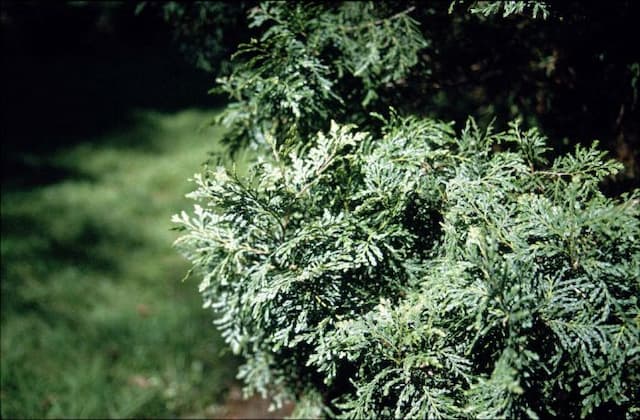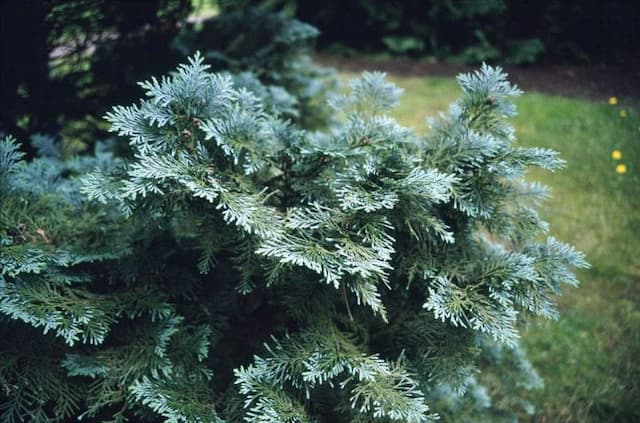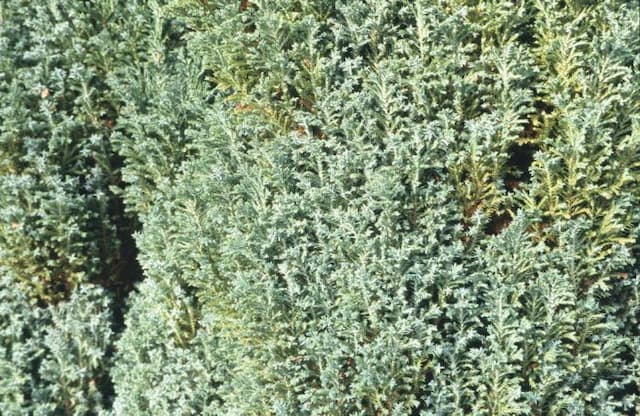Western Red Cedar Irish Gold Thuja plicata 'Irish Gold' (v)

ABOUT
The Thuja plicata 'Irish Gold,' commonly known as the Western Red Cedar, is an ornamental conifer distinguished by its vibrant foliage. It showcases an eye-catching golden-yellow hue that adds a splash of color to any garden or landscape. The needle-like leaves are scale-like in appearance, closely overlapping each other on downward drooping branches that give the plant a textured, lush quality. The bright golden color of the foliage is most prominent on the new growth, which often appears at the tips of the branches, contrasting with the deeper green color found towards the interior of the plant. The leaves emit a pleasant aroma when crushed, a characteristic feature of the Western Red Cedar. This cultivar retains its color throughout the seasons, maintaining its decorative appeal year-round. The overall shape of the foliage forms a conical silhouette that is dense and full, with a fine yet soft texture that is inviting to the touch. The distinctive color and form make 'Irish Gold' an attractive choice for gardeners looking to add evergreen interest and a touch of brightness to their planting schemes.
About this plant
 Names
NamesSynonyms
Western Red Cedar, Pacific Red Cedar, Giant Arborvitae, Shinglewood, Canoe Cedar
Common names
Thuja plicata 'Aurea', Thuja plicata 'Zebrina'.
 Toxicity
ToxicityTo humans
The Western Red Cedar, which includes 'Irish Gold', contains compounds that can be toxic when ingested. Consumption of parts of this plant can lead to gastrointestinal upset, such as nausea, vomiting, and diarrhea. In some cases, ingestion can cause skin irritation or more serious toxic effects, such as muscle weakness, breathing difficulties, or convulsions. Handling the plant can also cause contact dermatitis in sensitive individuals.
To pets
The Western Red Cedar, including the 'Irish Gold' variety, is also toxic to pets if ingested. Symptoms of poisoning in pets can include vomiting, diarrhea, excessive drooling, and abdominal pain. In more severe cases, there may be signs of muscle tremors, breathing difficulties, or changes in heart rate. It is advisable to prevent pets from consuming any part of this plant due to the potential toxic effects.
 Characteristics
CharacteristicsLife cycle
Perennials
Foliage type
Evergreen
Color of leaves
Yellow-green
Height
10-15 feet (3-4.5 meters)
Spread
3-4 feet (0.9-1.2 meters)
Plant type
Tree
Hardiness zones
5-7
Native area
North America
Benefits
 General Benefits
General Benefits- Ornamental Appeal: The Thuja plicata 'Irish Gold', commonly known as 'Western Red Cedar,' offers bright gold foliage that adds color and ornamental interest to the landscape.
- Privacy Screen: It can be used to create a natural privacy barrier in gardens and landscapes due to its dense growth habit.
- Windbreak: This plant can serve as a windbreak, protecting smaller plants and garden areas from strong winds.
- Low Maintenance: Once established, it requires minimal care and is relatively low maintenance compared to other garden plants.
- Drought Resistance: It has the ability to withstand periods of drought after establishment, making it suitable for xeriscaping.
- Habitat for Wildlife: Provides shelter and nesting sites for birds and other wildlife.
- Evergreen: As an evergreen, it retains its foliage year-round, providing color and structure to the garden even in winter.
 Medical Properties
Medical PropertiesThis plant is not used for medical purposes.
 Air-purifying Qualities
Air-purifying QualitiesThis plant is not specifically known for air purifying qualities.
 Other Uses
Other Uses- Woodworking Projects: The wood of Thuja plicata 'Irish Gold' is lightweight and resistant to decay, making it suitable for small woodworking projects such as decorative boxes or carving.
- Garden Structure: Mature plants of Thuja plicata 'Irish Gold' can be used to create living garden structures, such as archways or green walls, due to their dense foliage and sturdy form.
- Natural Dye: The foliage and bark of Thuja plicata 'Irish Gold' can be used for making natural dyes for textiles, producing varying shades of brown and green.
- Acoustic Control: Planting Thuja plicata 'Irish Gold' in groups can help dampen noise pollution in urban environments because its foliage can act as a natural sound barrier.
- Privacy Screens: The dense habit and fast growth rate make Thuja plicata 'Irish Gold' an ideal choice for creating privacy screens in residential areas.
- Windbreaks: Tall rows of Thuja plicata 'Irish Gold' can be planted to provide windbreaks that protect smaller plants and reduce soil erosion on farmlands.
- Topiary Art: The pliable branches and dense foliage of Thuja plicata 'Irish Gold' make it suitable for fashioning into topiary art, and it can be sculpted into a variety of shapes.
- Cultural Significance: Some indigenous cultures use the wood of Thuja plicata 'Irish Gold' for spiritual artifacts and ceremonial purposes due to its cultural significance and durability.
- Festive Decorations: The branches of Thuja plicata 'Irish Gold' can be used to create wreaths and other festive decorations, especially around Christmas due to its evergreen nature.
- Wildlife Shelter: The dense foliage provides cover and nesting opportunities for birds and other wildlife, offering an important habitat within gardens and parks.
Interesting Facts
 Feng Shui
Feng ShuiThe Western Red Cedar is not used in Feng Shui practice.
 Zodiac Sign Compitability
Zodiac Sign CompitabilityThe Western Red Cedar is not used in astrology practice.
 Plant Symbolism
Plant Symbolism- Everlasting Life: As an evergreen, Thuja plicata, commonly known as Western Red Cedar, symbolizes eternal life because it retains its foliage throughout the seasons.
- Protection: Western Red Cedar has been historically used to create totem poles and canoes by Native Americans, representing a symbol of shelter and safety.
- Purity: The tree's fragrant wood and its resistance to decay and pests give it a connotation of purification and cleanliness.
- Healing: Due to its antifungal and antibacterial properties, Western Red Cedar is associated with healing and medicine.
 Water
WaterThe Western Red Cedar 'Irish Gold' should be watered thoroughly, and the soil should be kept evenly moist but not waterlogged. During the first growing season, it’s important to water it weekly with about 1-2 gallons per week depending on rainfall and soil type. Once established, it needs less frequent watering, but during prolonged dry spells, a deep watering every two to three weeks is beneficial. Adjust the amount of water based on weather conditions, with less water needed during cool, rainy periods and more during hot, dry spells.
 Light
LightThe Western Red Cedar 'Irish Gold' thrives best in full sun to partial shade. A spot that receives at least 4-6 hours of direct sunlight with some dappled shade during the hottest part of the day is ideal. Avoid deep shade as it can lead to sparse growth and a less vibrant color.
 Temperature
TemperatureWestern Red Cedar 'Irish Gold' is hardy and can endure a temperature range from about -30 to 70 degrees Fahrenheit. Ideally, it prefers a cooler climate with temperatures ranging between 40 and 60 degrees Fahrenheit for robust growth. Extreme heat can stress the plant, so providing some shade during the hottest parts of the day in warmer regions can help maintain its health.
 Pruning
PruningPruning the Western Red Cedar 'Irish Gold' is mainly for aesthetic shaping and to remove any damaged or diseased branches. The best time to prune is in the late winter or early spring before new growth starts. It's typically not necessary to prune annually; doing it every 2-3 years is often enough unless shaping is required more frequently for landscape design.
 Cleaning
CleaningAs needed
 Soil
SoilWestern Red Cedar 'Irish Gold' prefers moist, well-draining soil with a mix of peat, compost, and coarse sand to ensure proper drainage. The soil pH should be slightly acidic to neutral, ranging from 5.5 to 7.0 for optimal growth.
 Repotting
RepottingWestern Red Cedar 'Irish Gold' does not require frequent repotting as it is typically grown as an outdoor plant. It may only need repotting if it is kept in a container, which should be done every 2 to 3 years to refresh the soil and provide room for growth.
 Humidity & Misting
Humidity & MistingWestern Red Cedar 'Irish Gold' tolerates a wide range of humidity levels typical of outdoor environments. It does not require any specific humidity adjustments when grown outdoors in its natural climate.
 Suitable locations
Suitable locationsIndoor
Ensure bright light, cool temperatures, and infrequent watering.
Outdoor
Plant in full sun to partial shade with well-drained soil.
Hardiness zone
5-7 USDA
 Life cycle
Life cycleThe life cycle of the Western Red Cedar 'Irish Gold,' also known as Thuja plicata 'Irish Gold,' begins with seed germination, which is dependent on suitable environmental conditions, such as adequate moisture and light. Once germinated, the seedling grows, establishing roots and developing foliage, a process that can span several years. As a juvenile, the plant continues to grow in height and spread, forming its characteristic conical shape with yellowish-gold foliage, and will eventually reach maturity, at which point it can begin to reproduce. Pollination occurs through wind dispersion of pollen from the male cones to the female cones, which, after fertilization, produce seeds. Mature Western Red Cedar 'Irish Gold' can live for many years, during which time it may produce many generations of cones and seeds, continuing its life cycle. The plant eventually enters a phase of senescence, where growth slows and the plant may become more susceptible to environmental stresses, pests, and disease, leading to its eventual decline and death.
 Propogation
PropogationPropogation time
Late Winter to Spring
Western Red Cedar 'Irish Gold' is commonly propagated through semi-hardwood cuttings. The ideal time for taking cuttings is late summer to early fall when the current season's growth has begun to harden but is still flexible. To do this, select healthy shoot tips about 4 to 6 inches (10 to 15 centimeters) long, ensuring each cutting has several sets of leaves. Dip the cut end in rooting hormone powder to increase the chances of successful root development. Then, insert the cuttings into a well-draining soil mix, like peat or sand mixed with perlite, ensuring the leaves do not touch the soil to prevent rot. The cuttings should be kept moist and in a warm place with indirect light until roots have developed, which typically takes several weeks to a few months. Once rooted, the young plants can be potted up individually and eventually transplanted outdoors once they are sufficiently established and the weather conditions are suitable.









